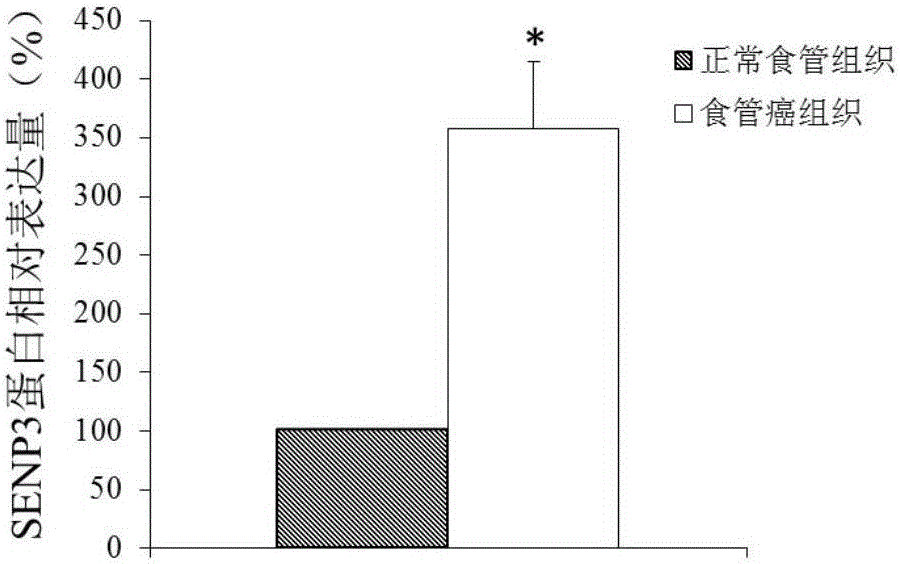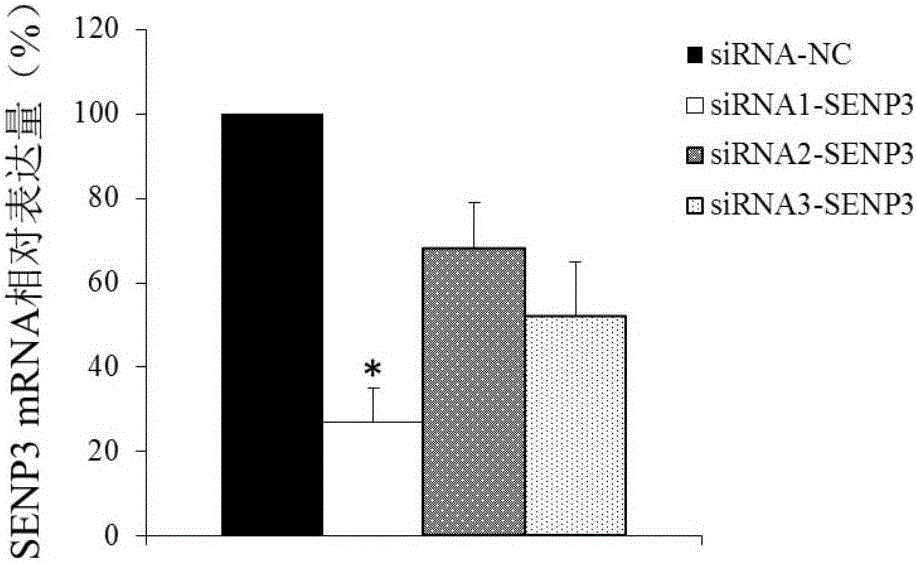SENP3 gene and use of its expression product as diagnosis and treatment target for esophageal cancer
A gene expression, esophageal cancer technology, applied in the biological field, can solve problems such as little value
- Summary
- Abstract
- Description
- Claims
- Application Information
AI Technical Summary
Problems solved by technology
Method used
Image
Examples
Embodiment 1
[0060] Example 1 Differential expression of SENP3 gene
[0061] 1. Experimental materials:
[0062] The esophageal cancer tissue is the specimen removed by the hospital's thoracic surgery, and the normal tissue is the specimen taken out under the microscope of the gastroscope room. Cut with a scalpel blade.
[0063] All cases were confirmed pathologically. Including 40 cases of esophageal cancer tissue and 30 cases of normal esophageal tissue. Among them, there were 34 cases of esophageal squamous cell carcinoma and 6 cases of esophageal adenocarcinoma. Normal esophageal tissue was used as the control group. All patients were pathologically confirmed before operation, and no radiotherapy, chemotherapy and other treatments were performed before operation, and no tumors in other parts were found. All tissues were stored in liquid nitrogen within half an hour of the operation, and then transferred to a -80°C refrigerator for freezing.
[0064] 2. Acquisition of RNA from eso...
Embodiment 2
[0074] Example 2 Differential expression of SENP3 protein
[0075] 1. The research object is the same as in Example 1.
[0076] 2. Extract tissue total protein
[0077]Follow the instructions of the EpiQuik Tissue / Cell Total Protein Extraction Kit for protein extraction.
[0078] 3. Western blot detection
[0079] The extracted protein was quantitatively subjected to SDS-PAGE electrophoresis, followed by membrane transfer, blocking, primary antibody incubation, secondary antibody incubation, and color development.
[0080] 4. Statistical processing
[0081] The gray value of the protein band was analyzed using Image J software, and the gray value of the SENP3 protein band was normalized with β-actin as an internal reference. The results and data are expressed in the form of mean ± standard deviation, and SPSS13.0 statistical software is used for statistical analysis. The difference between the two is tested by t test, and it is considered statistically significant when P<0...
Embodiment 3
[0084] Example 3 Inhibition of SENP3 gene expression
[0085] 1. siRNA design and synthesis
[0086] siRNA sequences targeting SENP3:
[0087] siRNA1-SENP3:
[0088] The sense strand is 5'-ACGUUUGAAGGAAUUCGUCCA-3' (SEQ ID NO.7);
[0089] The antisense strand is 5'-GACGAAUUCCUUCAAACGUAU-3' (SEQ ID NO.8),
[0090] siRNA2-SENP3:
[0091] The sense strand is 5'-AACUAUUGAAGAAAUGCACCU-3' (SEQ ID NO.9);
[0092] The antisense strand is 5'-GUGCAUUUCUUCAAUAGUUUC-3'(SEQ ID NO.10),
[0093] siRNA3-SENP3:
[0094] The sense strand is 5'-UAGAUACUUGGCAAUAUGCUU-3' (SEQ ID NO.11);
[0095] The antisense strand is 5'-GCAUAUUGCCAAGUAUCUACA-3' (SEQ ID NO.12)
[0096] Negative control siRNA sequence (siRNA-NC):
[0097] The sense strand is 5'-CGUACGCGGAAUACUUCGA-3' (SEQ ID NO.13);
[0098] The antisense strand is 5'-UCGAAGUAUUCCGCGUACG-3' (SEQ ID NO.14).
[0099] 2. Culture and transfection of esophageal cancer cells
[0100] 2.1 Cell culture
[0101] The esophageal cancer cell line ...
PUM
 Login to View More
Login to View More Abstract
Description
Claims
Application Information
 Login to View More
Login to View More - R&D
- Intellectual Property
- Life Sciences
- Materials
- Tech Scout
- Unparalleled Data Quality
- Higher Quality Content
- 60% Fewer Hallucinations
Browse by: Latest US Patents, China's latest patents, Technical Efficacy Thesaurus, Application Domain, Technology Topic, Popular Technical Reports.
© 2025 PatSnap. All rights reserved.Legal|Privacy policy|Modern Slavery Act Transparency Statement|Sitemap|About US| Contact US: help@patsnap.com



